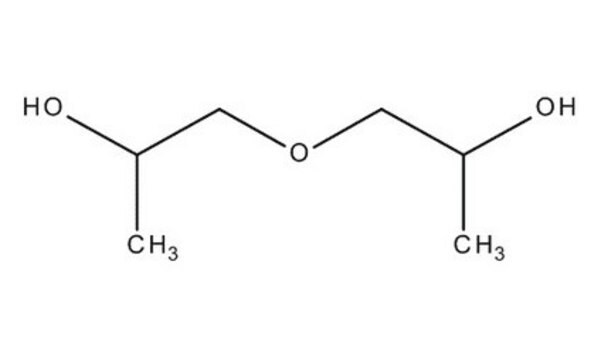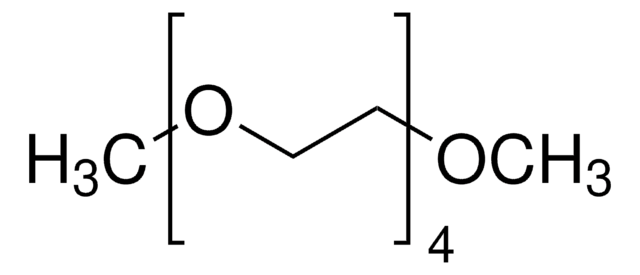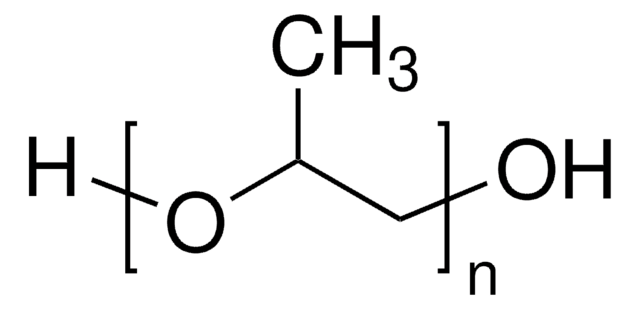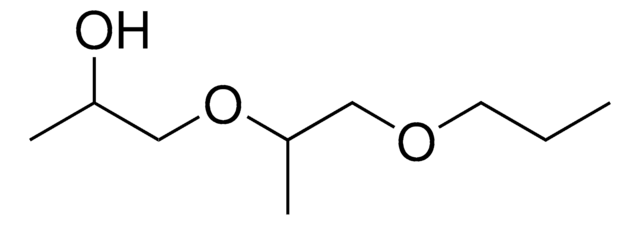187593
Tripropylene glycol
97%
Synonym(s):
[(1-Methyl-1,2-ethanediyl)bis(oxy)]bispropanol
Sign Into View Organizational & Contract Pricing
All Photos(1)
About This Item
Linear Formula:
H[OC2H3(CH3)]3OH
CAS Number:
Molecular Weight:
192.25
Beilstein:
2235421
EC Number:
UNSPSC Code:
12162002
NACRES:
NA.23
Recommended Products
vapor density
6.63 (vs air)
Quality Level
vapor pressure
<0.01 mmHg ( 25 °C)
Assay
97%
form
liquid
refractive index
n20/D 1.444 (lit.)
bp
273 °C (lit.)
density
1.021 g/mL at 25 °C (lit.)
InChI
1S/C9H20O4/c1-4-8(10)12-6-7(3)13-9(11)5-2/h7-11H,4-6H2,1-3H3
InChI key
SNAJJYBUNRAGEF-UHFFFAOYSA-N
Looking for similar products? Visit Product Comparison Guide
Application
- Development of New Dipropylene Glycol/Tripropylene Glycol Process: This research outlines the development of a new process for producing dipropylene glycol and tripropylene glycol, highlighting its market applications in denaturing and toughness enhancement (Yoshii et al., 2014).
- Synthesis of silver particles on bamboo charcoal: Utilizes tripropylene glycol as a reducing agent for the synthesis of silver nanoparticles, offering potential applications in material science for creating conductive and antibacterial surfaces (Chiang & Yeh, 2014).
- Tripropylene glycol diacrylate-based support ink: Discusses the modification of tripropylene glycol diacrylate for 3D printing applications, focusing on its use in creating support structures that can be easily removed post-manufacture (He et al., 2017).
- Viscosity of epoxy acrylate-tripropylene glycol diacrylate mixtures: Studies the temperature dependence of viscosity in these mixtures, important for applications in ultraviolet-curable coatings, which are widely used in both material science and industrial applications (Liu et al., 2015).
- Combustion and emissions in diesel engines: Investigates the use of tripropylene glycol as an additive in diesel fuel to improve combustion and reduce exhaust emissions, relevant for environmental chemistry and energy sector applications (Hazar, 2017).
Storage Class Code
10 - Combustible liquids
WGK
WGK 1
Flash Point(F)
293.0 °F - closed cup
Flash Point(C)
145 °C - closed cup
Personal Protective Equipment
dust mask type N95 (US), Eyeshields, Gloves
Choose from one of the most recent versions:
Already Own This Product?
Find documentation for the products that you have recently purchased in the Document Library.
Customers Also Viewed
Our team of scientists has experience in all areas of research including Life Science, Material Science, Chemical Synthesis, Chromatography, Analytical and many others.
Contact Technical Service












